A Detailed Analysis of Marks & Spencer's Competitive Strategies
VerifiedAdded on 2020/02/14
|17
|5896
|261
Report
AI Summary
This report provides a comprehensive competitive analysis of Marks & Spencer, a leading UK retailer. It examines the company's competitive positioning within the retail industry, including comparisons with competitors like Morrison, Tesco, and Asda. The analysis utilizes Porter's Five Forces model to assess the competitive landscape, focusing on threats from new entrants, substitute products, customer and supplier bargaining power, and existing market competition. The report also explores Marks & Spencer's strategic positioning, highlighting its use of differentiation and cost leadership strategies to gain a competitive edge. It delves into the application of Porter's generic strategies and the importance of product differentiation for growth and market share. The report emphasizes the company's focus on innovation, new product development, and customer loyalty to maintain its market position and profitability. The study also touches upon the company's sales revenue and its presence in various markets.
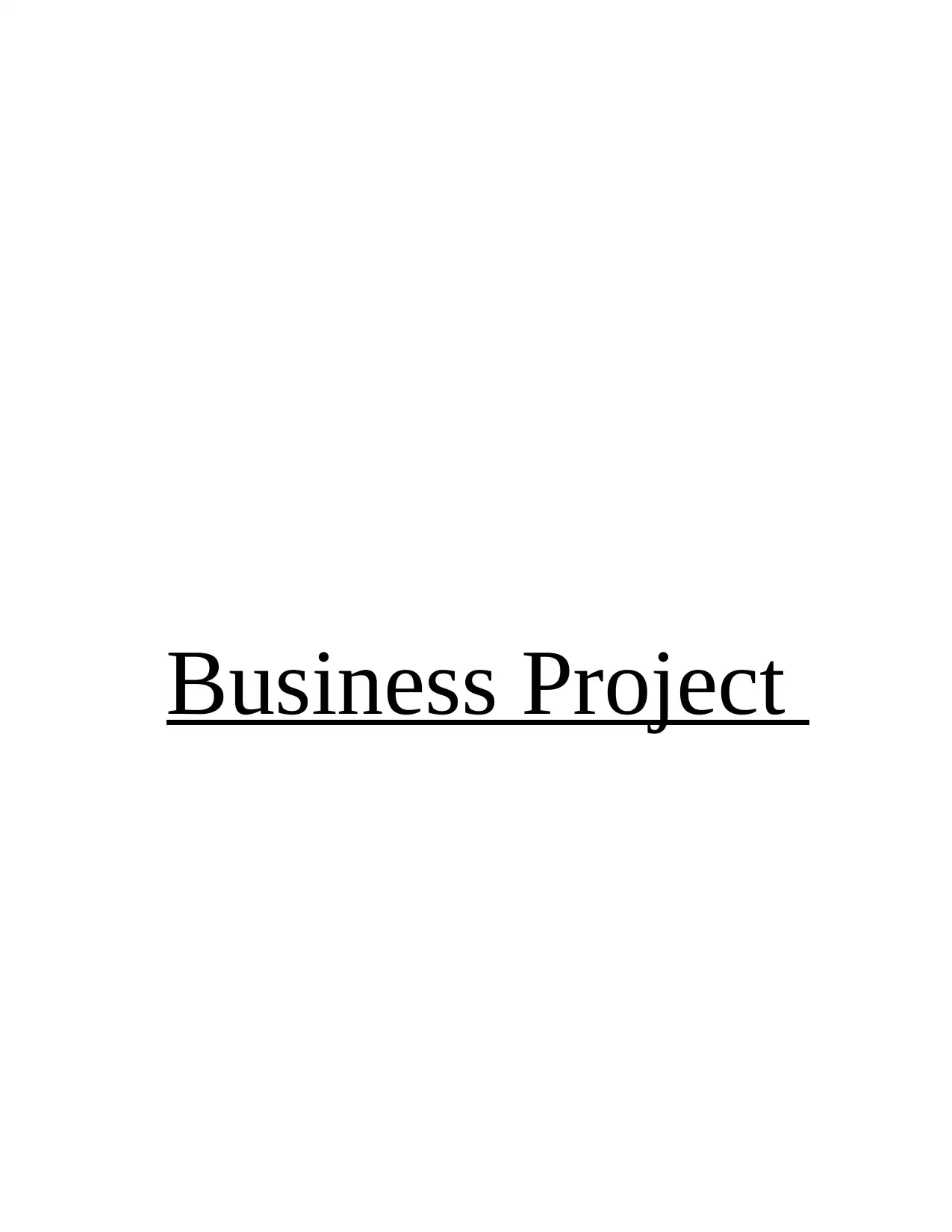
Business Project
Paraphrase This Document
Need a fresh take? Get an instant paraphrase of this document with our AI Paraphraser
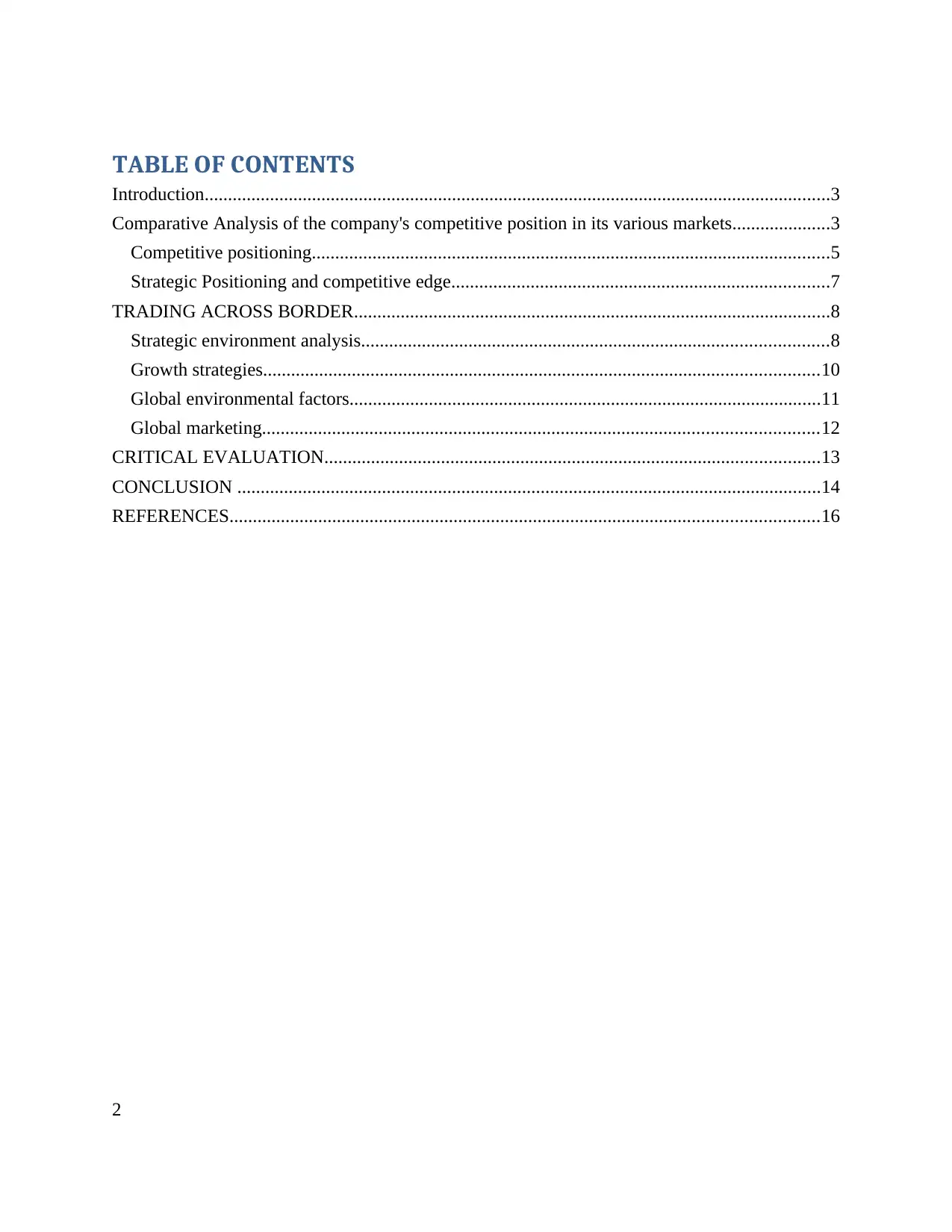
TABLE OF CONTENTS
Introduction......................................................................................................................................3
Comparative Analysis of the company's competitive position in its various markets.....................3
Competitive positioning...............................................................................................................5
Strategic Positioning and competitive edge.................................................................................7
TRADING ACROSS BORDER......................................................................................................8
Strategic environment analysis....................................................................................................8
Growth strategies.......................................................................................................................10
Global environmental factors.....................................................................................................11
Global marketing.......................................................................................................................12
CRITICAL EVALUATION..........................................................................................................13
CONCLUSION .............................................................................................................................14
REFERENCES..............................................................................................................................16
2
Introduction......................................................................................................................................3
Comparative Analysis of the company's competitive position in its various markets.....................3
Competitive positioning...............................................................................................................5
Strategic Positioning and competitive edge.................................................................................7
TRADING ACROSS BORDER......................................................................................................8
Strategic environment analysis....................................................................................................8
Growth strategies.......................................................................................................................10
Global environmental factors.....................................................................................................11
Global marketing.......................................................................................................................12
CRITICAL EVALUATION..........................................................................................................13
CONCLUSION .............................................................................................................................14
REFERENCES..............................................................................................................................16
2
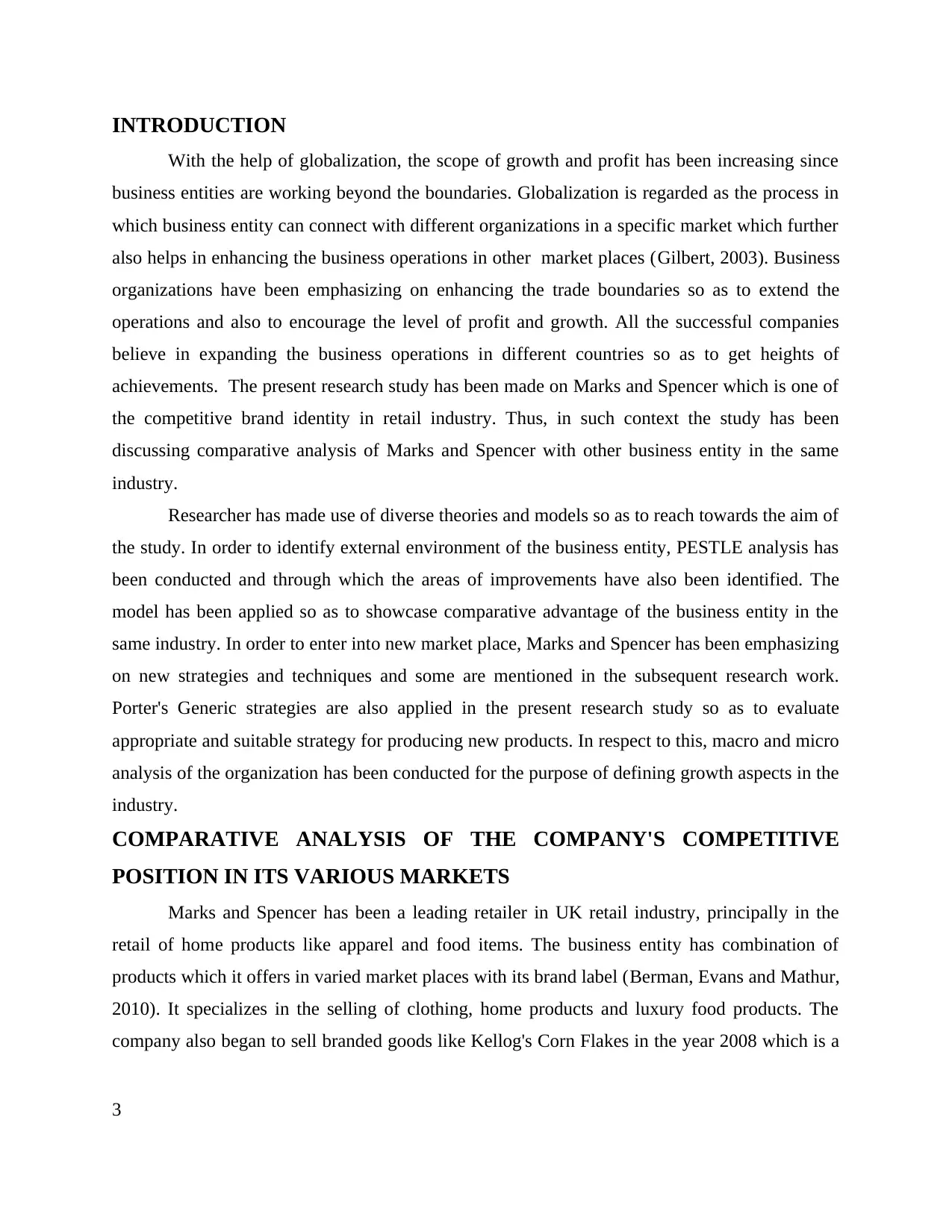
INTRODUCTION
With the help of globalization, the scope of growth and profit has been increasing since
business entities are working beyond the boundaries. Globalization is regarded as the process in
which business entity can connect with different organizations in a specific market which further
also helps in enhancing the business operations in other market places (Gilbert, 2003). Business
organizations have been emphasizing on enhancing the trade boundaries so as to extend the
operations and also to encourage the level of profit and growth. All the successful companies
believe in expanding the business operations in different countries so as to get heights of
achievements. The present research study has been made on Marks and Spencer which is one of
the competitive brand identity in retail industry. Thus, in such context the study has been
discussing comparative analysis of Marks and Spencer with other business entity in the same
industry.
Researcher has made use of diverse theories and models so as to reach towards the aim of
the study. In order to identify external environment of the business entity, PESTLE analysis has
been conducted and through which the areas of improvements have also been identified. The
model has been applied so as to showcase comparative advantage of the business entity in the
same industry. In order to enter into new market place, Marks and Spencer has been emphasizing
on new strategies and techniques and some are mentioned in the subsequent research work.
Porter's Generic strategies are also applied in the present research study so as to evaluate
appropriate and suitable strategy for producing new products. In respect to this, macro and micro
analysis of the organization has been conducted for the purpose of defining growth aspects in the
industry.
COMPARATIVE ANALYSIS OF THE COMPANY'S COMPETITIVE
POSITION IN ITS VARIOUS MARKETS
Marks and Spencer has been a leading retailer in UK retail industry, principally in the
retail of home products like apparel and food items. The business entity has combination of
products which it offers in varied market places with its brand label (Berman, Evans and Mathur,
2010). It specializes in the selling of clothing, home products and luxury food products. The
company also began to sell branded goods like Kellog's Corn Flakes in the year 2008 which is a
3
With the help of globalization, the scope of growth and profit has been increasing since
business entities are working beyond the boundaries. Globalization is regarded as the process in
which business entity can connect with different organizations in a specific market which further
also helps in enhancing the business operations in other market places (Gilbert, 2003). Business
organizations have been emphasizing on enhancing the trade boundaries so as to extend the
operations and also to encourage the level of profit and growth. All the successful companies
believe in expanding the business operations in different countries so as to get heights of
achievements. The present research study has been made on Marks and Spencer which is one of
the competitive brand identity in retail industry. Thus, in such context the study has been
discussing comparative analysis of Marks and Spencer with other business entity in the same
industry.
Researcher has made use of diverse theories and models so as to reach towards the aim of
the study. In order to identify external environment of the business entity, PESTLE analysis has
been conducted and through which the areas of improvements have also been identified. The
model has been applied so as to showcase comparative advantage of the business entity in the
same industry. In order to enter into new market place, Marks and Spencer has been emphasizing
on new strategies and techniques and some are mentioned in the subsequent research work.
Porter's Generic strategies are also applied in the present research study so as to evaluate
appropriate and suitable strategy for producing new products. In respect to this, macro and micro
analysis of the organization has been conducted for the purpose of defining growth aspects in the
industry.
COMPARATIVE ANALYSIS OF THE COMPANY'S COMPETITIVE
POSITION IN ITS VARIOUS MARKETS
Marks and Spencer has been a leading retailer in UK retail industry, principally in the
retail of home products like apparel and food items. The business entity has combination of
products which it offers in varied market places with its brand label (Berman, Evans and Mathur,
2010). It specializes in the selling of clothing, home products and luxury food products. The
company also began to sell branded goods like Kellog's Corn Flakes in the year 2008 which is a
3
⊘ This is a preview!⊘
Do you want full access?
Subscribe today to unlock all pages.

Trusted by 1+ million students worldwide
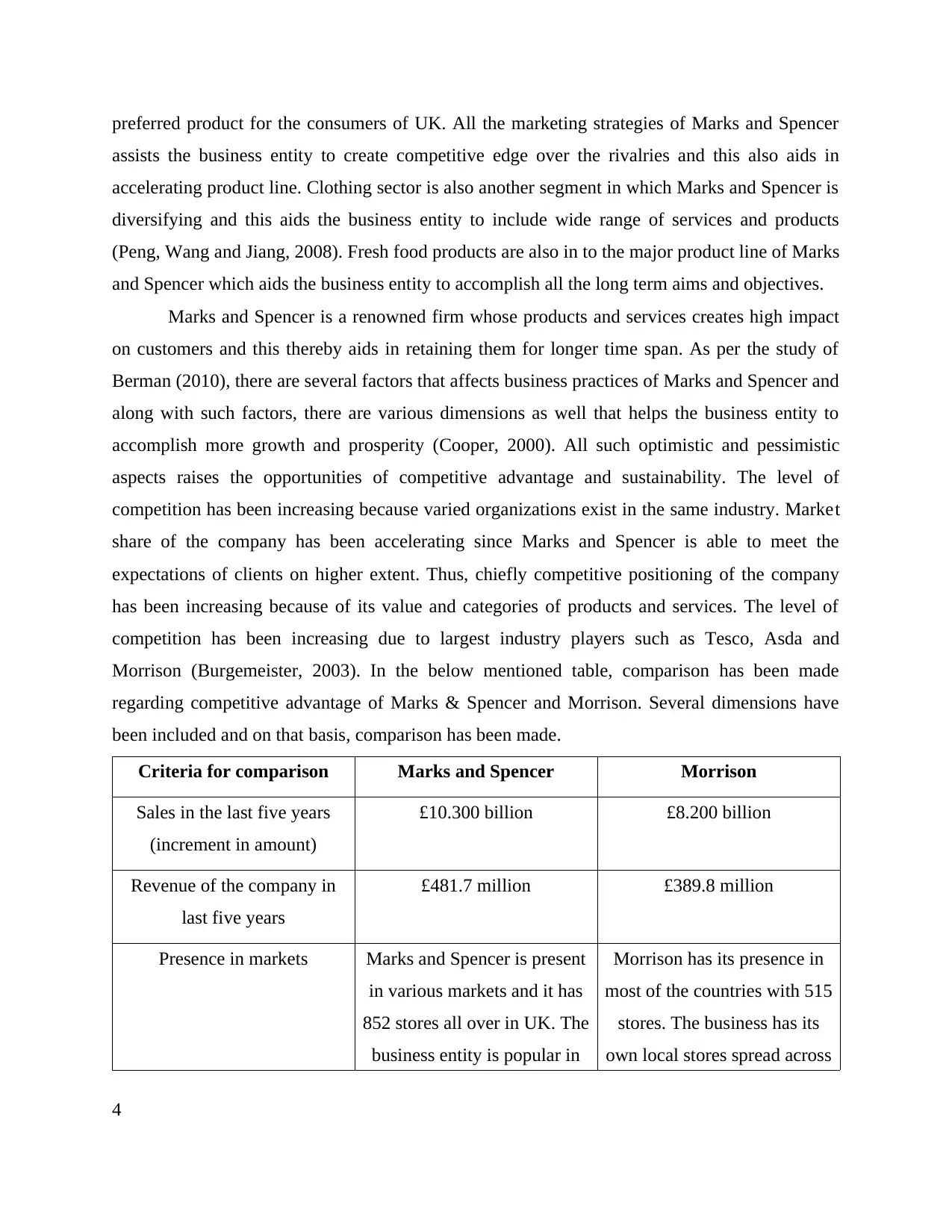
preferred product for the consumers of UK. All the marketing strategies of Marks and Spencer
assists the business entity to create competitive edge over the rivalries and this also aids in
accelerating product line. Clothing sector is also another segment in which Marks and Spencer is
diversifying and this aids the business entity to include wide range of services and products
(Peng, Wang and Jiang, 2008). Fresh food products are also in to the major product line of Marks
and Spencer which aids the business entity to accomplish all the long term aims and objectives.
Marks and Spencer is a renowned firm whose products and services creates high impact
on customers and this thereby aids in retaining them for longer time span. As per the study of
Berman (2010), there are several factors that affects business practices of Marks and Spencer and
along with such factors, there are various dimensions as well that helps the business entity to
accomplish more growth and prosperity (Cooper, 2000). All such optimistic and pessimistic
aspects raises the opportunities of competitive advantage and sustainability. The level of
competition has been increasing because varied organizations exist in the same industry. Market
share of the company has been accelerating since Marks and Spencer is able to meet the
expectations of clients on higher extent. Thus, chiefly competitive positioning of the company
has been increasing because of its value and categories of products and services. The level of
competition has been increasing due to largest industry players such as Tesco, Asda and
Morrison (Burgemeister, 2003). In the below mentioned table, comparison has been made
regarding competitive advantage of Marks & Spencer and Morrison. Several dimensions have
been included and on that basis, comparison has been made.
Criteria for comparison Marks and Spencer Morrison
Sales in the last five years
(increment in amount)
£10.300 billion £8.200 billion
Revenue of the company in
last five years
£481.7 million £389.8 million
Presence in markets Marks and Spencer is present
in various markets and it has
852 stores all over in UK. The
business entity is popular in
Morrison has its presence in
most of the countries with 515
stores. The business has its
own local stores spread across
4
assists the business entity to create competitive edge over the rivalries and this also aids in
accelerating product line. Clothing sector is also another segment in which Marks and Spencer is
diversifying and this aids the business entity to include wide range of services and products
(Peng, Wang and Jiang, 2008). Fresh food products are also in to the major product line of Marks
and Spencer which aids the business entity to accomplish all the long term aims and objectives.
Marks and Spencer is a renowned firm whose products and services creates high impact
on customers and this thereby aids in retaining them for longer time span. As per the study of
Berman (2010), there are several factors that affects business practices of Marks and Spencer and
along with such factors, there are various dimensions as well that helps the business entity to
accomplish more growth and prosperity (Cooper, 2000). All such optimistic and pessimistic
aspects raises the opportunities of competitive advantage and sustainability. The level of
competition has been increasing because varied organizations exist in the same industry. Market
share of the company has been accelerating since Marks and Spencer is able to meet the
expectations of clients on higher extent. Thus, chiefly competitive positioning of the company
has been increasing because of its value and categories of products and services. The level of
competition has been increasing due to largest industry players such as Tesco, Asda and
Morrison (Burgemeister, 2003). In the below mentioned table, comparison has been made
regarding competitive advantage of Marks & Spencer and Morrison. Several dimensions have
been included and on that basis, comparison has been made.
Criteria for comparison Marks and Spencer Morrison
Sales in the last five years
(increment in amount)
£10.300 billion £8.200 billion
Revenue of the company in
last five years
£481.7 million £389.8 million
Presence in markets Marks and Spencer is present
in various markets and it has
852 stores all over in UK. The
business entity is popular in
Morrison has its presence in
most of the countries with 515
stores. The business has its
own local stores spread across
4
Paraphrase This Document
Need a fresh take? Get an instant paraphrase of this document with our AI Paraphraser
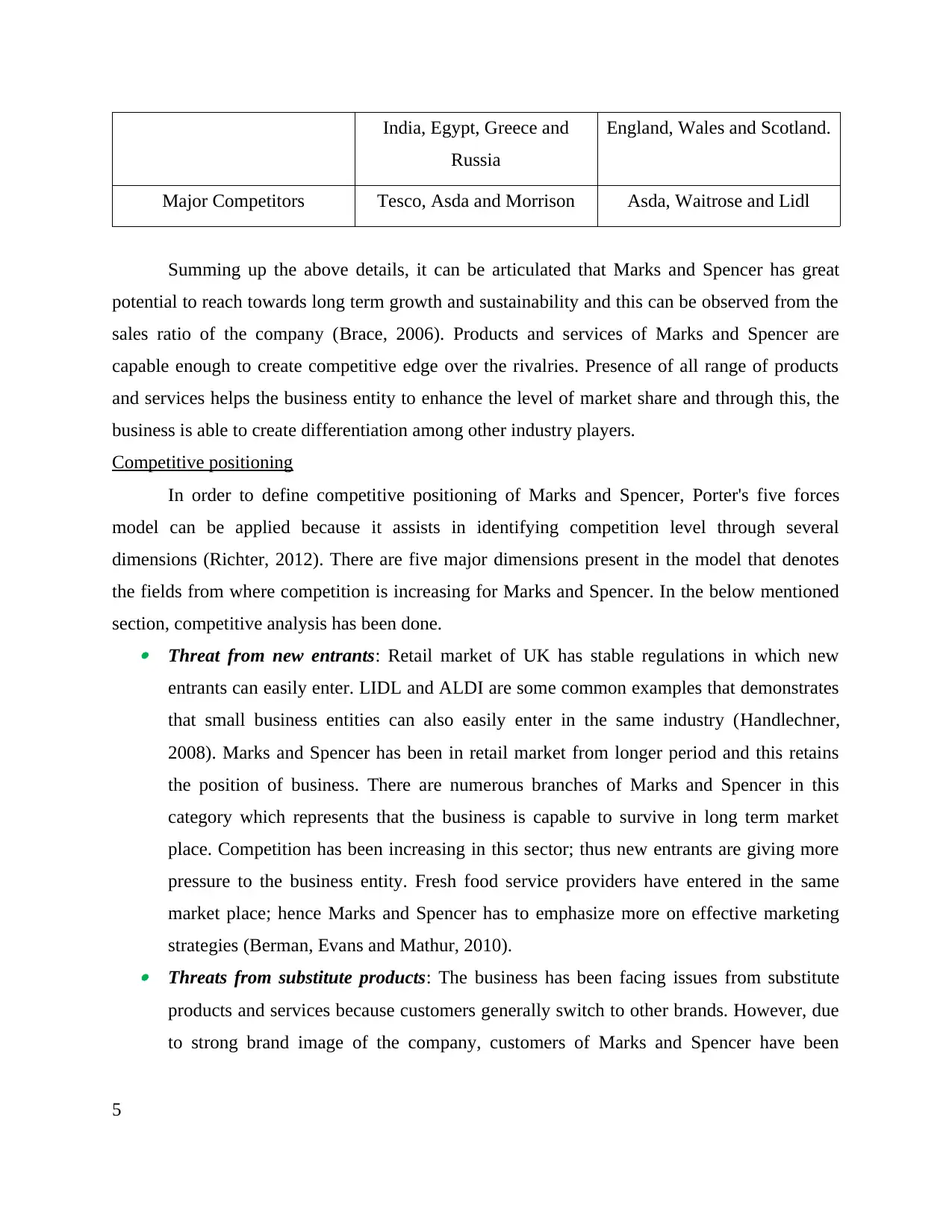
India, Egypt, Greece and
Russia
England, Wales and Scotland.
Major Competitors Tesco, Asda and Morrison Asda, Waitrose and Lidl
Summing up the above details, it can be articulated that Marks and Spencer has great
potential to reach towards long term growth and sustainability and this can be observed from the
sales ratio of the company (Brace, 2006). Products and services of Marks and Spencer are
capable enough to create competitive edge over the rivalries. Presence of all range of products
and services helps the business entity to enhance the level of market share and through this, the
business is able to create differentiation among other industry players.
Competitive positioning
In order to define competitive positioning of Marks and Spencer, Porter's five forces
model can be applied because it assists in identifying competition level through several
dimensions (Richter, 2012). There are five major dimensions present in the model that denotes
the fields from where competition is increasing for Marks and Spencer. In the below mentioned
section, competitive analysis has been done. Threat from new entrants: Retail market of UK has stable regulations in which new
entrants can easily enter. LIDL and ALDI are some common examples that demonstrates
that small business entities can also easily enter in the same industry (Handlechner,
2008). Marks and Spencer has been in retail market from longer period and this retains
the position of business. There are numerous branches of Marks and Spencer in this
category which represents that the business is capable to survive in long term market
place. Competition has been increasing in this sector; thus new entrants are giving more
pressure to the business entity. Fresh food service providers have entered in the same
market place; hence Marks and Spencer has to emphasize more on effective marketing
strategies (Berman, Evans and Mathur, 2010). Threats from substitute products: The business has been facing issues from substitute
products and services because customers generally switch to other brands. However, due
to strong brand image of the company, customers of Marks and Spencer have been
5
Russia
England, Wales and Scotland.
Major Competitors Tesco, Asda and Morrison Asda, Waitrose and Lidl
Summing up the above details, it can be articulated that Marks and Spencer has great
potential to reach towards long term growth and sustainability and this can be observed from the
sales ratio of the company (Brace, 2006). Products and services of Marks and Spencer are
capable enough to create competitive edge over the rivalries. Presence of all range of products
and services helps the business entity to enhance the level of market share and through this, the
business is able to create differentiation among other industry players.
Competitive positioning
In order to define competitive positioning of Marks and Spencer, Porter's five forces
model can be applied because it assists in identifying competition level through several
dimensions (Richter, 2012). There are five major dimensions present in the model that denotes
the fields from where competition is increasing for Marks and Spencer. In the below mentioned
section, competitive analysis has been done. Threat from new entrants: Retail market of UK has stable regulations in which new
entrants can easily enter. LIDL and ALDI are some common examples that demonstrates
that small business entities can also easily enter in the same industry (Handlechner,
2008). Marks and Spencer has been in retail market from longer period and this retains
the position of business. There are numerous branches of Marks and Spencer in this
category which represents that the business is capable to survive in long term market
place. Competition has been increasing in this sector; thus new entrants are giving more
pressure to the business entity. Fresh food service providers have entered in the same
market place; hence Marks and Spencer has to emphasize more on effective marketing
strategies (Berman, Evans and Mathur, 2010). Threats from substitute products: The business has been facing issues from substitute
products and services because customers generally switch to other brands. However, due
to strong brand image of the company, customers of Marks and Spencer have been
5
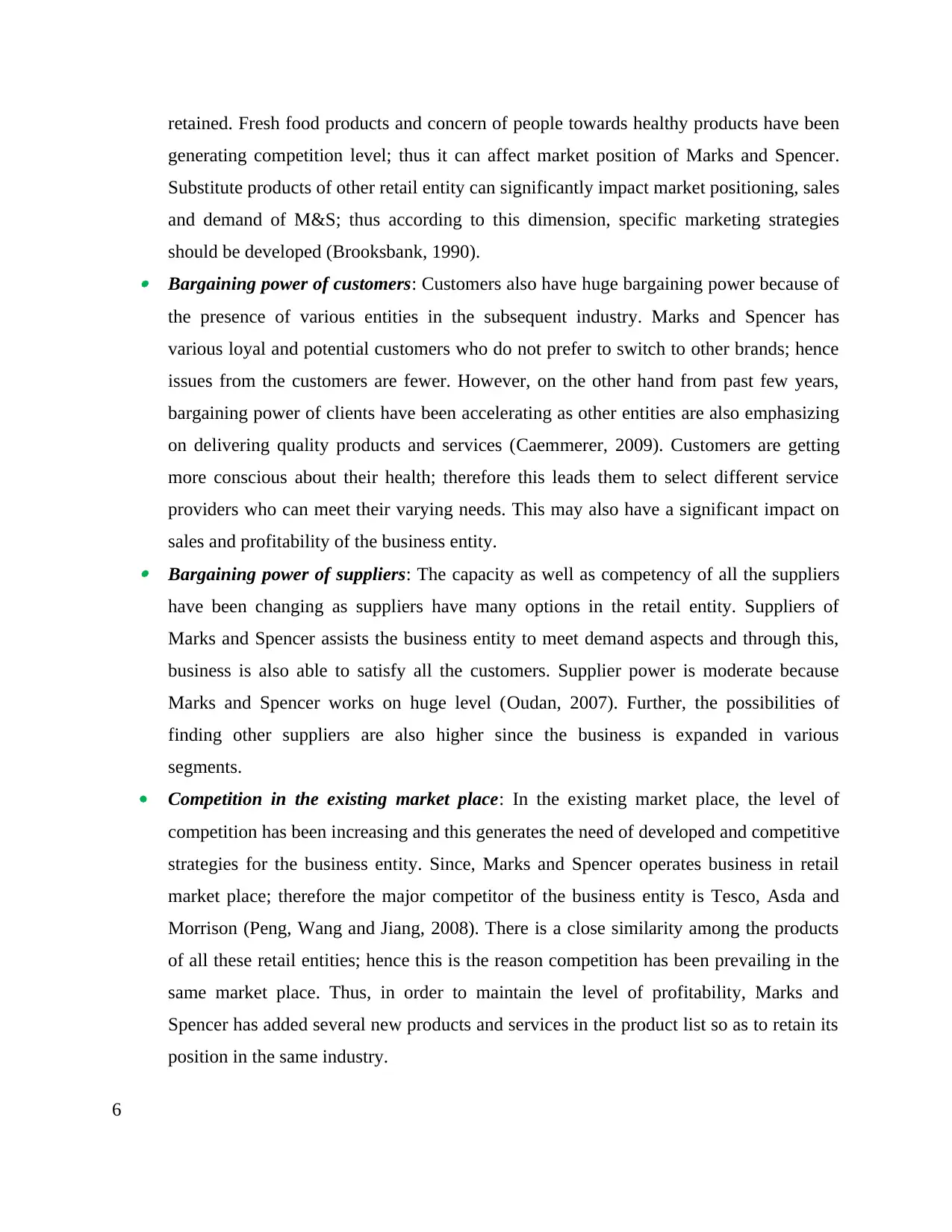
retained. Fresh food products and concern of people towards healthy products have been
generating competition level; thus it can affect market position of Marks and Spencer.
Substitute products of other retail entity can significantly impact market positioning, sales
and demand of M&S; thus according to this dimension, specific marketing strategies
should be developed (Brooksbank, 1990). Bargaining power of customers: Customers also have huge bargaining power because of
the presence of various entities in the subsequent industry. Marks and Spencer has
various loyal and potential customers who do not prefer to switch to other brands; hence
issues from the customers are fewer. However, on the other hand from past few years,
bargaining power of clients have been accelerating as other entities are also emphasizing
on delivering quality products and services (Caemmerer, 2009). Customers are getting
more conscious about their health; therefore this leads them to select different service
providers who can meet their varying needs. This may also have a significant impact on
sales and profitability of the business entity. Bargaining power of suppliers: The capacity as well as competency of all the suppliers
have been changing as suppliers have many options in the retail entity. Suppliers of
Marks and Spencer assists the business entity to meet demand aspects and through this,
business is also able to satisfy all the customers. Supplier power is moderate because
Marks and Spencer works on huge level (Oudan, 2007). Further, the possibilities of
finding other suppliers are also higher since the business is expanded in various
segments.
Competition in the existing market place: In the existing market place, the level of
competition has been increasing and this generates the need of developed and competitive
strategies for the business entity. Since, Marks and Spencer operates business in retail
market place; therefore the major competitor of the business entity is Tesco, Asda and
Morrison (Peng, Wang and Jiang, 2008). There is a close similarity among the products
of all these retail entities; hence this is the reason competition has been prevailing in the
same market place. Thus, in order to maintain the level of profitability, Marks and
Spencer has added several new products and services in the product list so as to retain its
position in the same industry.
6
generating competition level; thus it can affect market position of Marks and Spencer.
Substitute products of other retail entity can significantly impact market positioning, sales
and demand of M&S; thus according to this dimension, specific marketing strategies
should be developed (Brooksbank, 1990). Bargaining power of customers: Customers also have huge bargaining power because of
the presence of various entities in the subsequent industry. Marks and Spencer has
various loyal and potential customers who do not prefer to switch to other brands; hence
issues from the customers are fewer. However, on the other hand from past few years,
bargaining power of clients have been accelerating as other entities are also emphasizing
on delivering quality products and services (Caemmerer, 2009). Customers are getting
more conscious about their health; therefore this leads them to select different service
providers who can meet their varying needs. This may also have a significant impact on
sales and profitability of the business entity. Bargaining power of suppliers: The capacity as well as competency of all the suppliers
have been changing as suppliers have many options in the retail entity. Suppliers of
Marks and Spencer assists the business entity to meet demand aspects and through this,
business is also able to satisfy all the customers. Supplier power is moderate because
Marks and Spencer works on huge level (Oudan, 2007). Further, the possibilities of
finding other suppliers are also higher since the business is expanded in various
segments.
Competition in the existing market place: In the existing market place, the level of
competition has been increasing and this generates the need of developed and competitive
strategies for the business entity. Since, Marks and Spencer operates business in retail
market place; therefore the major competitor of the business entity is Tesco, Asda and
Morrison (Peng, Wang and Jiang, 2008). There is a close similarity among the products
of all these retail entities; hence this is the reason competition has been prevailing in the
same market place. Thus, in order to maintain the level of profitability, Marks and
Spencer has added several new products and services in the product list so as to retain its
position in the same industry.
6
⊘ This is a preview!⊘
Do you want full access?
Subscribe today to unlock all pages.

Trusted by 1+ million students worldwide
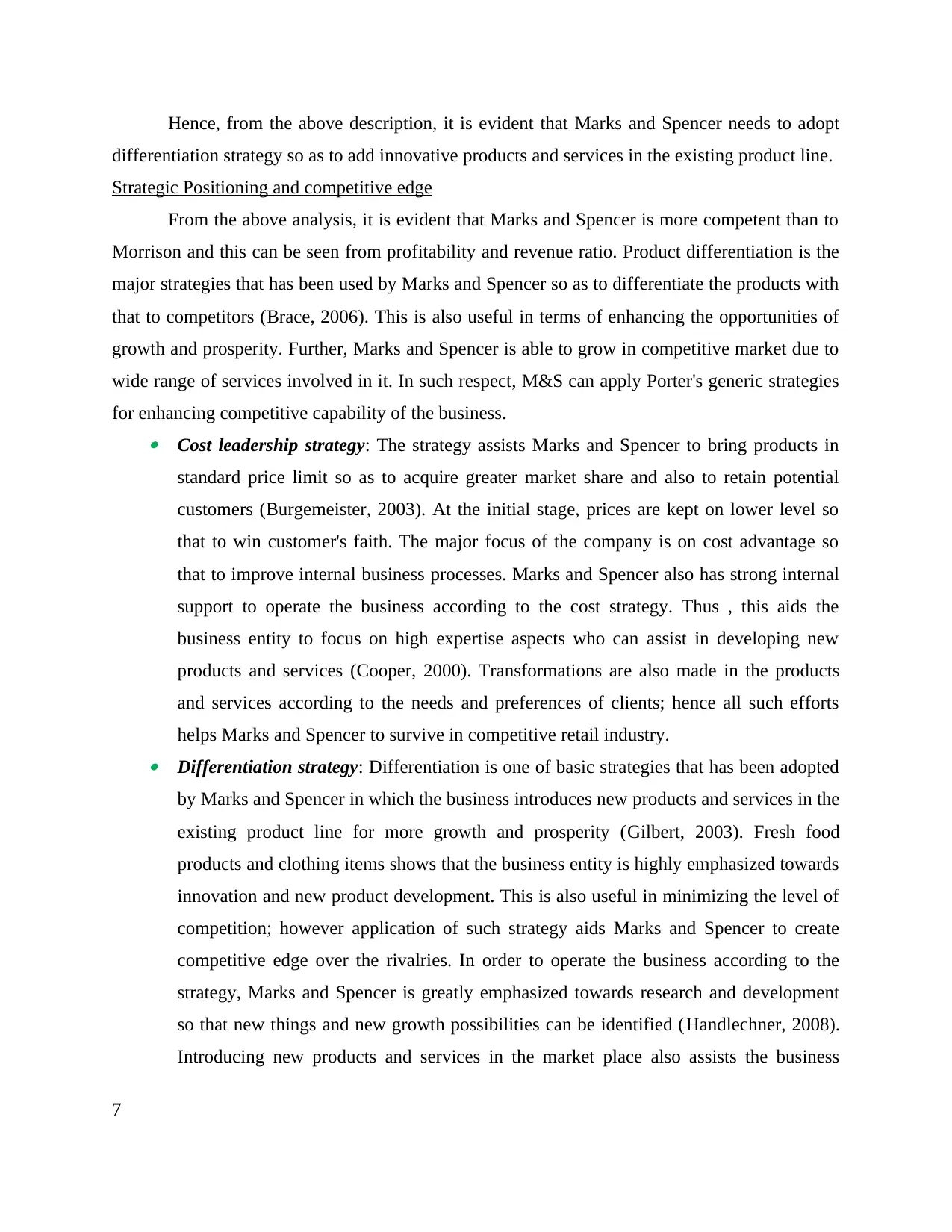
Hence, from the above description, it is evident that Marks and Spencer needs to adopt
differentiation strategy so as to add innovative products and services in the existing product line.
Strategic Positioning and competitive edge
From the above analysis, it is evident that Marks and Spencer is more competent than to
Morrison and this can be seen from profitability and revenue ratio. Product differentiation is the
major strategies that has been used by Marks and Spencer so as to differentiate the products with
that to competitors (Brace, 2006). This is also useful in terms of enhancing the opportunities of
growth and prosperity. Further, Marks and Spencer is able to grow in competitive market due to
wide range of services involved in it. In such respect, M&S can apply Porter's generic strategies
for enhancing competitive capability of the business. Cost leadership strategy: The strategy assists Marks and Spencer to bring products in
standard price limit so as to acquire greater market share and also to retain potential
customers (Burgemeister, 2003). At the initial stage, prices are kept on lower level so
that to win customer's faith. The major focus of the company is on cost advantage so
that to improve internal business processes. Marks and Spencer also has strong internal
support to operate the business according to the cost strategy. Thus , this aids the
business entity to focus on high expertise aspects who can assist in developing new
products and services (Cooper, 2000). Transformations are also made in the products
and services according to the needs and preferences of clients; hence all such efforts
helps Marks and Spencer to survive in competitive retail industry. Differentiation strategy: Differentiation is one of basic strategies that has been adopted
by Marks and Spencer in which the business introduces new products and services in the
existing product line for more growth and prosperity (Gilbert, 2003). Fresh food
products and clothing items shows that the business entity is highly emphasized towards
innovation and new product development. This is also useful in minimizing the level of
competition; however application of such strategy aids Marks and Spencer to create
competitive edge over the rivalries. In order to operate the business according to the
strategy, Marks and Spencer is greatly emphasized towards research and development
so that new things and new growth possibilities can be identified (Handlechner, 2008).
Introducing new products and services in the market place also assists the business
7
differentiation strategy so as to add innovative products and services in the existing product line.
Strategic Positioning and competitive edge
From the above analysis, it is evident that Marks and Spencer is more competent than to
Morrison and this can be seen from profitability and revenue ratio. Product differentiation is the
major strategies that has been used by Marks and Spencer so as to differentiate the products with
that to competitors (Brace, 2006). This is also useful in terms of enhancing the opportunities of
growth and prosperity. Further, Marks and Spencer is able to grow in competitive market due to
wide range of services involved in it. In such respect, M&S can apply Porter's generic strategies
for enhancing competitive capability of the business. Cost leadership strategy: The strategy assists Marks and Spencer to bring products in
standard price limit so as to acquire greater market share and also to retain potential
customers (Burgemeister, 2003). At the initial stage, prices are kept on lower level so
that to win customer's faith. The major focus of the company is on cost advantage so
that to improve internal business processes. Marks and Spencer also has strong internal
support to operate the business according to the cost strategy. Thus , this aids the
business entity to focus on high expertise aspects who can assist in developing new
products and services (Cooper, 2000). Transformations are also made in the products
and services according to the needs and preferences of clients; hence all such efforts
helps Marks and Spencer to survive in competitive retail industry. Differentiation strategy: Differentiation is one of basic strategies that has been adopted
by Marks and Spencer in which the business introduces new products and services in the
existing product line for more growth and prosperity (Gilbert, 2003). Fresh food
products and clothing items shows that the business entity is highly emphasized towards
innovation and new product development. This is also useful in minimizing the level of
competition; however application of such strategy aids Marks and Spencer to create
competitive edge over the rivalries. In order to operate the business according to the
strategy, Marks and Spencer is greatly emphasized towards research and development
so that new things and new growth possibilities can be identified (Handlechner, 2008).
Introducing new products and services in the market place also assists the business
7
Paraphrase This Document
Need a fresh take? Get an instant paraphrase of this document with our AI Paraphraser
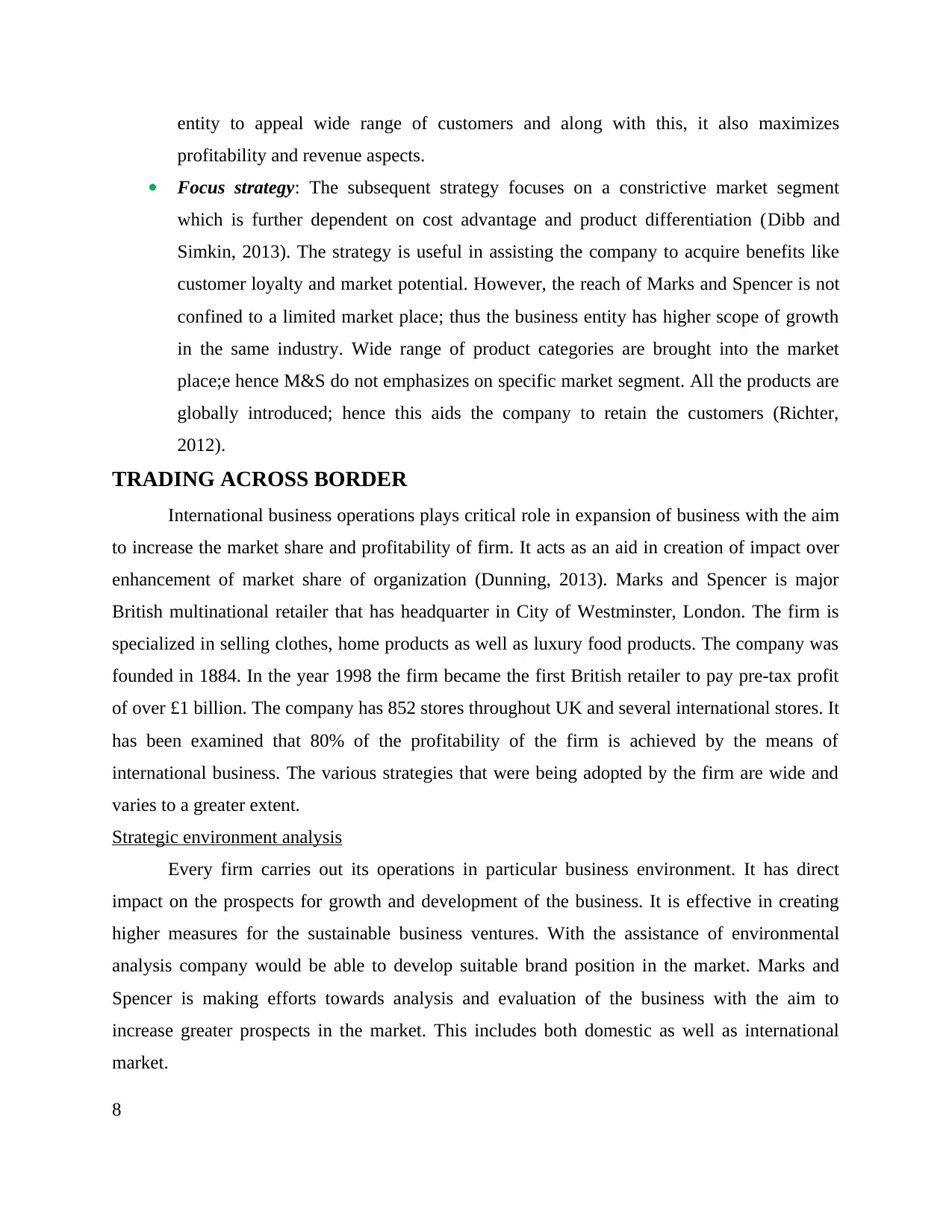
entity to appeal wide range of customers and along with this, it also maximizes
profitability and revenue aspects.
Focus strategy: The subsequent strategy focuses on a constrictive market segment
which is further dependent on cost advantage and product differentiation (Dibb and
Simkin, 2013). The strategy is useful in assisting the company to acquire benefits like
customer loyalty and market potential. However, the reach of Marks and Spencer is not
confined to a limited market place; thus the business entity has higher scope of growth
in the same industry. Wide range of product categories are brought into the market
place;e hence M&S do not emphasizes on specific market segment. All the products are
globally introduced; hence this aids the company to retain the customers (Richter,
2012).
TRADING ACROSS BORDER
International business operations plays critical role in expansion of business with the aim
to increase the market share and profitability of firm. It acts as an aid in creation of impact over
enhancement of market share of organization (Dunning, 2013). Marks and Spencer is major
British multinational retailer that has headquarter in City of Westminster, London. The firm is
specialized in selling clothes, home products as well as luxury food products. The company was
founded in 1884. In the year 1998 the firm became the first British retailer to pay pre-tax profit
of over £1 billion. The company has 852 stores throughout UK and several international stores. It
has been examined that 80% of the profitability of the firm is achieved by the means of
international business. The various strategies that were being adopted by the firm are wide and
varies to a greater extent.
Strategic environment analysis
Every firm carries out its operations in particular business environment. It has direct
impact on the prospects for growth and development of the business. It is effective in creating
higher measures for the sustainable business ventures. With the assistance of environmental
analysis company would be able to develop suitable brand position in the market. Marks and
Spencer is making efforts towards analysis and evaluation of the business with the aim to
increase greater prospects in the market. This includes both domestic as well as international
market.
8
profitability and revenue aspects.
Focus strategy: The subsequent strategy focuses on a constrictive market segment
which is further dependent on cost advantage and product differentiation (Dibb and
Simkin, 2013). The strategy is useful in assisting the company to acquire benefits like
customer loyalty and market potential. However, the reach of Marks and Spencer is not
confined to a limited market place; thus the business entity has higher scope of growth
in the same industry. Wide range of product categories are brought into the market
place;e hence M&S do not emphasizes on specific market segment. All the products are
globally introduced; hence this aids the company to retain the customers (Richter,
2012).
TRADING ACROSS BORDER
International business operations plays critical role in expansion of business with the aim
to increase the market share and profitability of firm. It acts as an aid in creation of impact over
enhancement of market share of organization (Dunning, 2013). Marks and Spencer is major
British multinational retailer that has headquarter in City of Westminster, London. The firm is
specialized in selling clothes, home products as well as luxury food products. The company was
founded in 1884. In the year 1998 the firm became the first British retailer to pay pre-tax profit
of over £1 billion. The company has 852 stores throughout UK and several international stores. It
has been examined that 80% of the profitability of the firm is achieved by the means of
international business. The various strategies that were being adopted by the firm are wide and
varies to a greater extent.
Strategic environment analysis
Every firm carries out its operations in particular business environment. It has direct
impact on the prospects for growth and development of the business. It is effective in creating
higher measures for the sustainable business ventures. With the assistance of environmental
analysis company would be able to develop suitable brand position in the market. Marks and
Spencer is making efforts towards analysis and evaluation of the business with the aim to
increase greater prospects in the market. This includes both domestic as well as international
market.
8
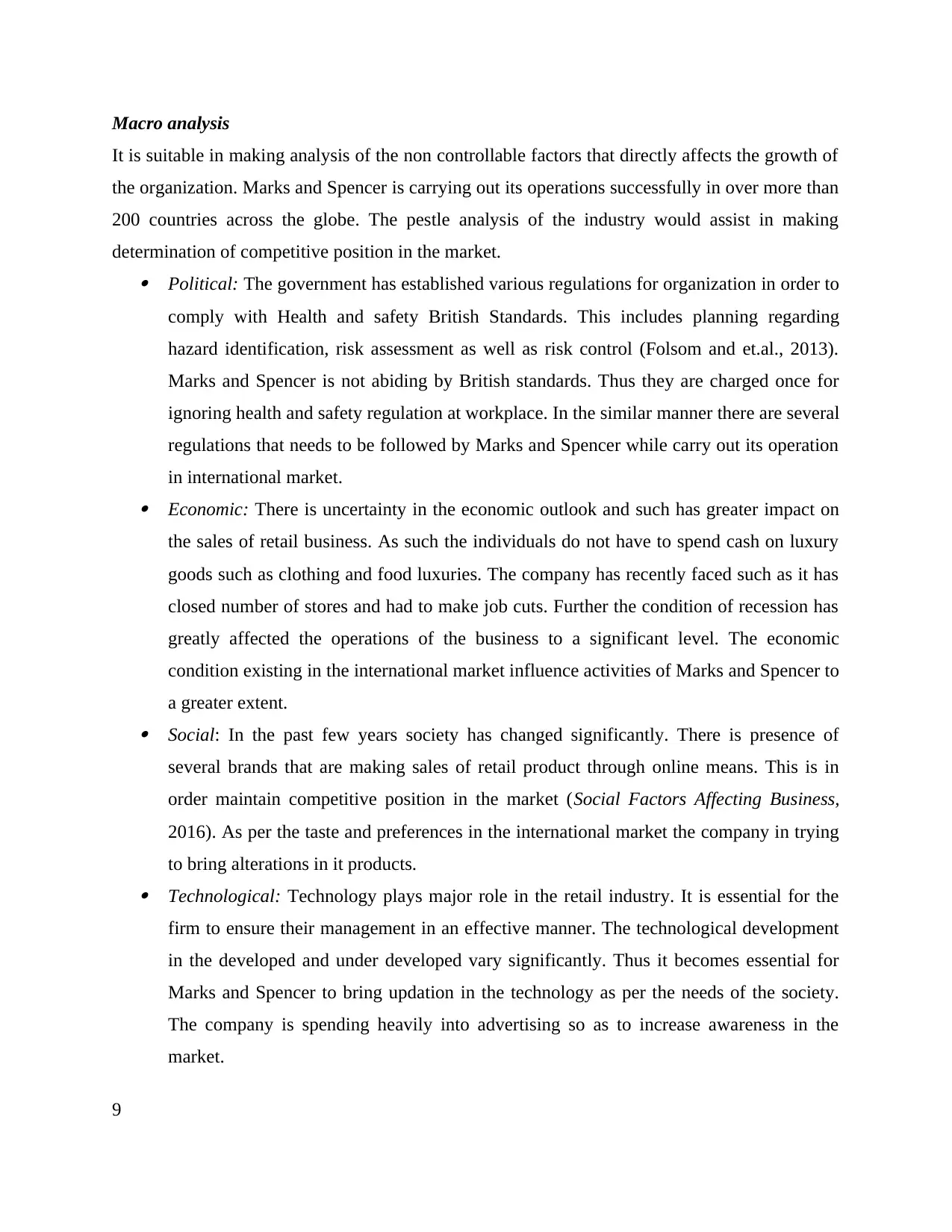
Macro analysis
It is suitable in making analysis of the non controllable factors that directly affects the growth of
the organization. Marks and Spencer is carrying out its operations successfully in over more than
200 countries across the globe. The pestle analysis of the industry would assist in making
determination of competitive position in the market. Political: The government has established various regulations for organization in order to
comply with Health and safety British Standards. This includes planning regarding
hazard identification, risk assessment as well as risk control (Folsom and et.al., 2013).
Marks and Spencer is not abiding by British standards. Thus they are charged once for
ignoring health and safety regulation at workplace. In the similar manner there are several
regulations that needs to be followed by Marks and Spencer while carry out its operation
in international market. Economic: There is uncertainty in the economic outlook and such has greater impact on
the sales of retail business. As such the individuals do not have to spend cash on luxury
goods such as clothing and food luxuries. The company has recently faced such as it has
closed number of stores and had to make job cuts. Further the condition of recession has
greatly affected the operations of the business to a significant level. The economic
condition existing in the international market influence activities of Marks and Spencer to
a greater extent. Social: In the past few years society has changed significantly. There is presence of
several brands that are making sales of retail product through online means. This is in
order maintain competitive position in the market (Social Factors Affecting Business,
2016). As per the taste and preferences in the international market the company in trying
to bring alterations in it products. Technological: Technology plays major role in the retail industry. It is essential for the
firm to ensure their management in an effective manner. The technological development
in the developed and under developed vary significantly. Thus it becomes essential for
Marks and Spencer to bring updation in the technology as per the needs of the society.
The company is spending heavily into advertising so as to increase awareness in the
market.
9
It is suitable in making analysis of the non controllable factors that directly affects the growth of
the organization. Marks and Spencer is carrying out its operations successfully in over more than
200 countries across the globe. The pestle analysis of the industry would assist in making
determination of competitive position in the market. Political: The government has established various regulations for organization in order to
comply with Health and safety British Standards. This includes planning regarding
hazard identification, risk assessment as well as risk control (Folsom and et.al., 2013).
Marks and Spencer is not abiding by British standards. Thus they are charged once for
ignoring health and safety regulation at workplace. In the similar manner there are several
regulations that needs to be followed by Marks and Spencer while carry out its operation
in international market. Economic: There is uncertainty in the economic outlook and such has greater impact on
the sales of retail business. As such the individuals do not have to spend cash on luxury
goods such as clothing and food luxuries. The company has recently faced such as it has
closed number of stores and had to make job cuts. Further the condition of recession has
greatly affected the operations of the business to a significant level. The economic
condition existing in the international market influence activities of Marks and Spencer to
a greater extent. Social: In the past few years society has changed significantly. There is presence of
several brands that are making sales of retail product through online means. This is in
order maintain competitive position in the market (Social Factors Affecting Business,
2016). As per the taste and preferences in the international market the company in trying
to bring alterations in it products. Technological: Technology plays major role in the retail industry. It is essential for the
firm to ensure their management in an effective manner. The technological development
in the developed and under developed vary significantly. Thus it becomes essential for
Marks and Spencer to bring updation in the technology as per the needs of the society.
The company is spending heavily into advertising so as to increase awareness in the
market.
9
⊘ This is a preview!⊘
Do you want full access?
Subscribe today to unlock all pages.

Trusted by 1+ million students worldwide
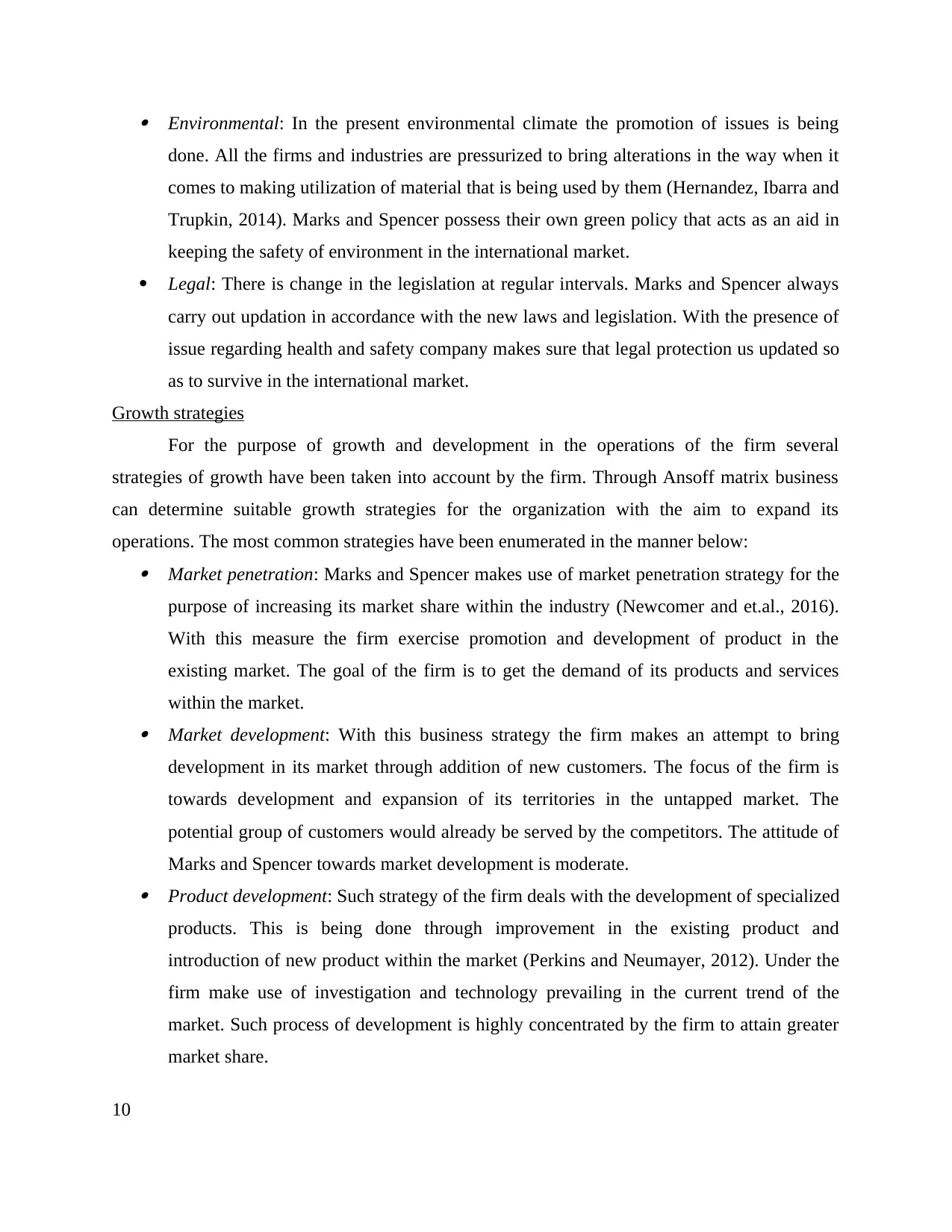
Environmental: In the present environmental climate the promotion of issues is being
done. All the firms and industries are pressurized to bring alterations in the way when it
comes to making utilization of material that is being used by them (Hernandez, Ibarra and
Trupkin, 2014). Marks and Spencer possess their own green policy that acts as an aid in
keeping the safety of environment in the international market.
Legal: There is change in the legislation at regular intervals. Marks and Spencer always
carry out updation in accordance with the new laws and legislation. With the presence of
issue regarding health and safety company makes sure that legal protection us updated so
as to survive in the international market.
Growth strategies
For the purpose of growth and development in the operations of the firm several
strategies of growth have been taken into account by the firm. Through Ansoff matrix business
can determine suitable growth strategies for the organization with the aim to expand its
operations. The most common strategies have been enumerated in the manner below: Market penetration: Marks and Spencer makes use of market penetration strategy for the
purpose of increasing its market share within the industry (Newcomer and et.al., 2016).
With this measure the firm exercise promotion and development of product in the
existing market. The goal of the firm is to get the demand of its products and services
within the market. Market development: With this business strategy the firm makes an attempt to bring
development in its market through addition of new customers. The focus of the firm is
towards development and expansion of its territories in the untapped market. The
potential group of customers would already be served by the competitors. The attitude of
Marks and Spencer towards market development is moderate. Product development: Such strategy of the firm deals with the development of specialized
products. This is being done through improvement in the existing product and
introduction of new product within the market (Perkins and Neumayer, 2012). Under the
firm make use of investigation and technology prevailing in the current trend of the
market. Such process of development is highly concentrated by the firm to attain greater
market share.
10
done. All the firms and industries are pressurized to bring alterations in the way when it
comes to making utilization of material that is being used by them (Hernandez, Ibarra and
Trupkin, 2014). Marks and Spencer possess their own green policy that acts as an aid in
keeping the safety of environment in the international market.
Legal: There is change in the legislation at regular intervals. Marks and Spencer always
carry out updation in accordance with the new laws and legislation. With the presence of
issue regarding health and safety company makes sure that legal protection us updated so
as to survive in the international market.
Growth strategies
For the purpose of growth and development in the operations of the firm several
strategies of growth have been taken into account by the firm. Through Ansoff matrix business
can determine suitable growth strategies for the organization with the aim to expand its
operations. The most common strategies have been enumerated in the manner below: Market penetration: Marks and Spencer makes use of market penetration strategy for the
purpose of increasing its market share within the industry (Newcomer and et.al., 2016).
With this measure the firm exercise promotion and development of product in the
existing market. The goal of the firm is to get the demand of its products and services
within the market. Market development: With this business strategy the firm makes an attempt to bring
development in its market through addition of new customers. The focus of the firm is
towards development and expansion of its territories in the untapped market. The
potential group of customers would already be served by the competitors. The attitude of
Marks and Spencer towards market development is moderate. Product development: Such strategy of the firm deals with the development of specialized
products. This is being done through improvement in the existing product and
introduction of new product within the market (Perkins and Neumayer, 2012). Under the
firm make use of investigation and technology prevailing in the current trend of the
market. Such process of development is highly concentrated by the firm to attain greater
market share.
10
Paraphrase This Document
Need a fresh take? Get an instant paraphrase of this document with our AI Paraphraser
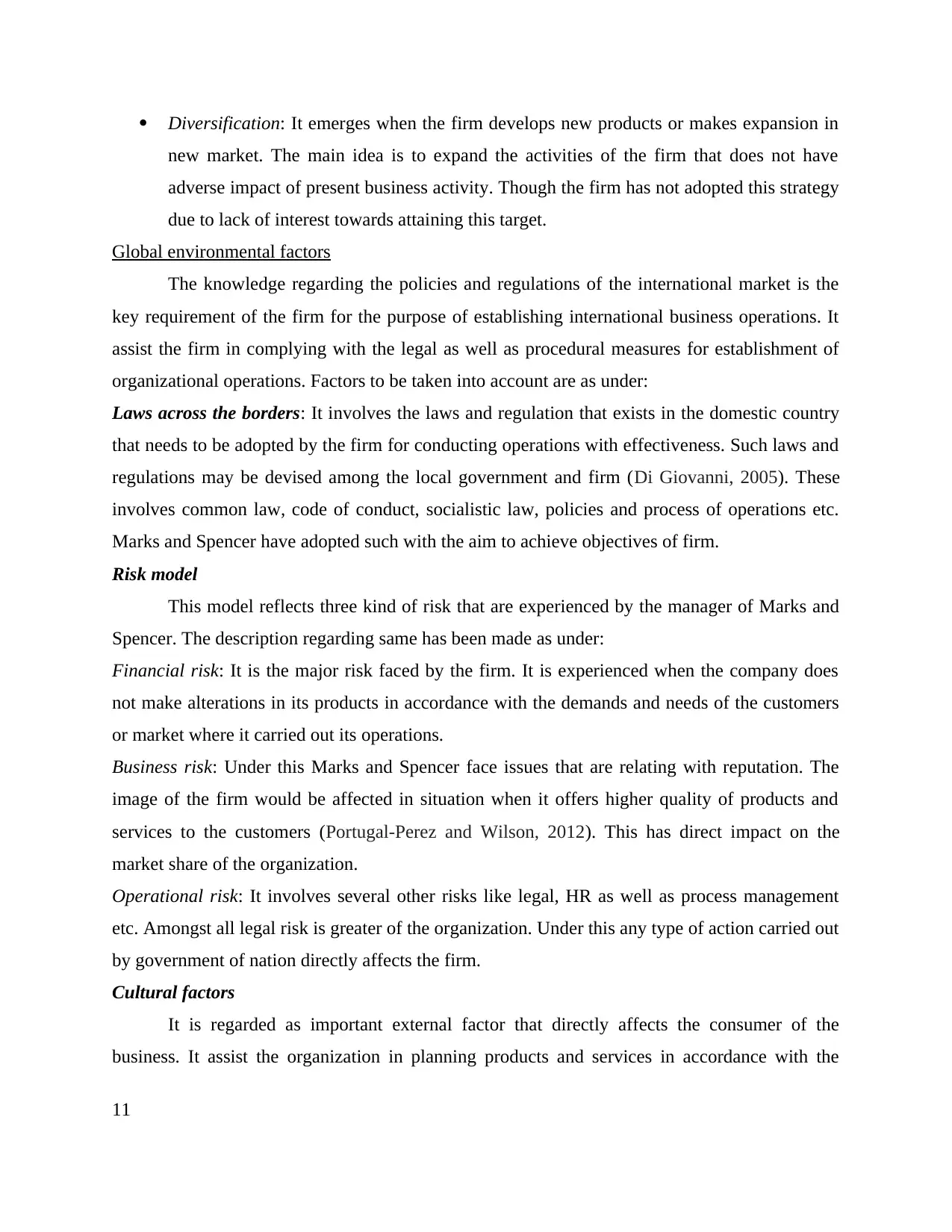
Diversification: It emerges when the firm develops new products or makes expansion in
new market. The main idea is to expand the activities of the firm that does not have
adverse impact of present business activity. Though the firm has not adopted this strategy
due to lack of interest towards attaining this target.
Global environmental factors
The knowledge regarding the policies and regulations of the international market is the
key requirement of the firm for the purpose of establishing international business operations. It
assist the firm in complying with the legal as well as procedural measures for establishment of
organizational operations. Factors to be taken into account are as under:
Laws across the borders: It involves the laws and regulation that exists in the domestic country
that needs to be adopted by the firm for conducting operations with effectiveness. Such laws and
regulations may be devised among the local government and firm (Di Giovanni, 2005). These
involves common law, code of conduct, socialistic law, policies and process of operations etc.
Marks and Spencer have adopted such with the aim to achieve objectives of firm.
Risk model
This model reflects three kind of risk that are experienced by the manager of Marks and
Spencer. The description regarding same has been made as under:
Financial risk: It is the major risk faced by the firm. It is experienced when the company does
not make alterations in its products in accordance with the demands and needs of the customers
or market where it carried out its operations.
Business risk: Under this Marks and Spencer face issues that are relating with reputation. The
image of the firm would be affected in situation when it offers higher quality of products and
services to the customers (Portugal-Perez and Wilson, 2012). This has direct impact on the
market share of the organization.
Operational risk: It involves several other risks like legal, HR as well as process management
etc. Amongst all legal risk is greater of the organization. Under this any type of action carried out
by government of nation directly affects the firm.
Cultural factors
It is regarded as important external factor that directly affects the consumer of the
business. It assist the organization in planning products and services in accordance with the
11
new market. The main idea is to expand the activities of the firm that does not have
adverse impact of present business activity. Though the firm has not adopted this strategy
due to lack of interest towards attaining this target.
Global environmental factors
The knowledge regarding the policies and regulations of the international market is the
key requirement of the firm for the purpose of establishing international business operations. It
assist the firm in complying with the legal as well as procedural measures for establishment of
organizational operations. Factors to be taken into account are as under:
Laws across the borders: It involves the laws and regulation that exists in the domestic country
that needs to be adopted by the firm for conducting operations with effectiveness. Such laws and
regulations may be devised among the local government and firm (Di Giovanni, 2005). These
involves common law, code of conduct, socialistic law, policies and process of operations etc.
Marks and Spencer have adopted such with the aim to achieve objectives of firm.
Risk model
This model reflects three kind of risk that are experienced by the manager of Marks and
Spencer. The description regarding same has been made as under:
Financial risk: It is the major risk faced by the firm. It is experienced when the company does
not make alterations in its products in accordance with the demands and needs of the customers
or market where it carried out its operations.
Business risk: Under this Marks and Spencer face issues that are relating with reputation. The
image of the firm would be affected in situation when it offers higher quality of products and
services to the customers (Portugal-Perez and Wilson, 2012). This has direct impact on the
market share of the organization.
Operational risk: It involves several other risks like legal, HR as well as process management
etc. Amongst all legal risk is greater of the organization. Under this any type of action carried out
by government of nation directly affects the firm.
Cultural factors
It is regarded as important external factor that directly affects the consumer of the
business. It assist the organization in planning products and services in accordance with the
11
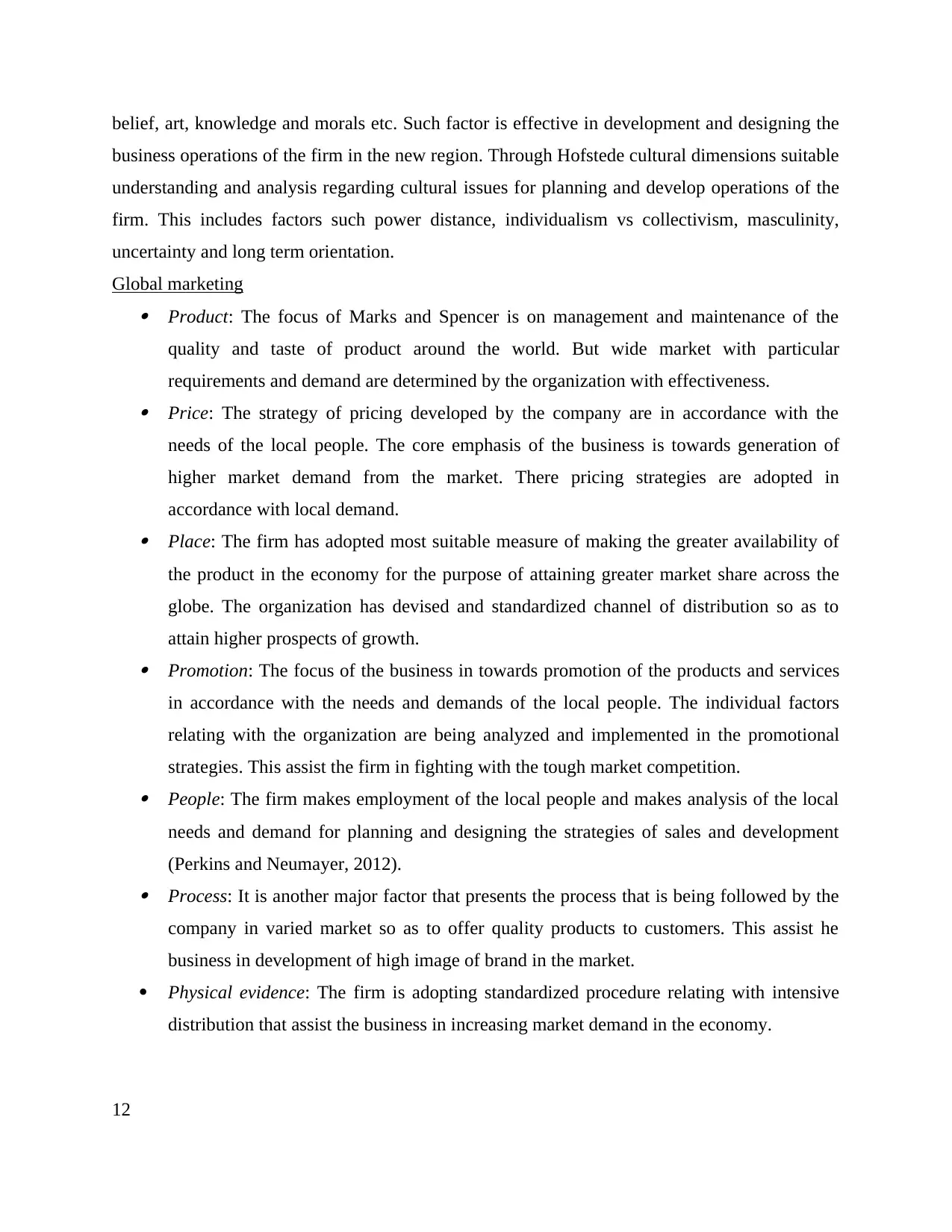
belief, art, knowledge and morals etc. Such factor is effective in development and designing the
business operations of the firm in the new region. Through Hofstede cultural dimensions suitable
understanding and analysis regarding cultural issues for planning and develop operations of the
firm. This includes factors such power distance, individualism vs collectivism, masculinity,
uncertainty and long term orientation.
Global marketing Product: The focus of Marks and Spencer is on management and maintenance of the
quality and taste of product around the world. But wide market with particular
requirements and demand are determined by the organization with effectiveness. Price: The strategy of pricing developed by the company are in accordance with the
needs of the local people. The core emphasis of the business is towards generation of
higher market demand from the market. There pricing strategies are adopted in
accordance with local demand. Place: The firm has adopted most suitable measure of making the greater availability of
the product in the economy for the purpose of attaining greater market share across the
globe. The organization has devised and standardized channel of distribution so as to
attain higher prospects of growth. Promotion: The focus of the business in towards promotion of the products and services
in accordance with the needs and demands of the local people. The individual factors
relating with the organization are being analyzed and implemented in the promotional
strategies. This assist the firm in fighting with the tough market competition. People: The firm makes employment of the local people and makes analysis of the local
needs and demand for planning and designing the strategies of sales and development
(Perkins and Neumayer, 2012). Process: It is another major factor that presents the process that is being followed by the
company in varied market so as to offer quality products to customers. This assist he
business in development of high image of brand in the market.
Physical evidence: The firm is adopting standardized procedure relating with intensive
distribution that assist the business in increasing market demand in the economy.
12
business operations of the firm in the new region. Through Hofstede cultural dimensions suitable
understanding and analysis regarding cultural issues for planning and develop operations of the
firm. This includes factors such power distance, individualism vs collectivism, masculinity,
uncertainty and long term orientation.
Global marketing Product: The focus of Marks and Spencer is on management and maintenance of the
quality and taste of product around the world. But wide market with particular
requirements and demand are determined by the organization with effectiveness. Price: The strategy of pricing developed by the company are in accordance with the
needs of the local people. The core emphasis of the business is towards generation of
higher market demand from the market. There pricing strategies are adopted in
accordance with local demand. Place: The firm has adopted most suitable measure of making the greater availability of
the product in the economy for the purpose of attaining greater market share across the
globe. The organization has devised and standardized channel of distribution so as to
attain higher prospects of growth. Promotion: The focus of the business in towards promotion of the products and services
in accordance with the needs and demands of the local people. The individual factors
relating with the organization are being analyzed and implemented in the promotional
strategies. This assist the firm in fighting with the tough market competition. People: The firm makes employment of the local people and makes analysis of the local
needs and demand for planning and designing the strategies of sales and development
(Perkins and Neumayer, 2012). Process: It is another major factor that presents the process that is being followed by the
company in varied market so as to offer quality products to customers. This assist he
business in development of high image of brand in the market.
Physical evidence: The firm is adopting standardized procedure relating with intensive
distribution that assist the business in increasing market demand in the economy.
12
⊘ This is a preview!⊘
Do you want full access?
Subscribe today to unlock all pages.

Trusted by 1+ million students worldwide
1 out of 17
Related Documents
Your All-in-One AI-Powered Toolkit for Academic Success.
+13062052269
info@desklib.com
Available 24*7 on WhatsApp / Email
![[object Object]](/_next/static/media/star-bottom.7253800d.svg)
Unlock your academic potential
Copyright © 2020–2025 A2Z Services. All Rights Reserved. Developed and managed by ZUCOL.




